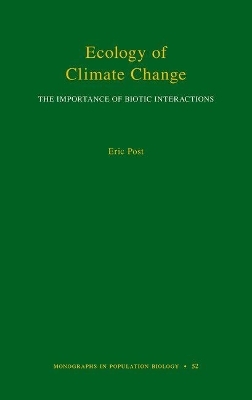
Ecology of Climate Change
Princeton University Press (Verlag)
978-0-691-14847-2 (ISBN)
He urges a more refined consideration of species interactions, emphasizing important distinctions between lateral and vertical interactions and their disparate roles in shaping responses of populations, communities, and ecosystems to climate change.
Eric Post is professor of biology and ecology at Pennsylvania State University. He has published dozens of scholarly articles and book chapters on ecological responses to climate change, and is coeditor of Wildlife Conservation in a Changing Climate.
Preface: Purpose, Perspective, and Scope xiii The Tension and Facilitation Hypotheses of Biotic Response to Climate Change xiv Acknowledgments xxi 1. A Brief Overview of Recent Climate Change and Its Ecological Context 1 * Climate Change versus Global Warming 3 * Temperature Changes 3 * Precipitation Changes 9 * Changes in Snow and Ice Cover 11 * El Nino-Southern Oscillation 13 * Paleoclimatic Variation 15 * Studying the Ecological Effects of Climate Change 16 * The Study Site at Kangerlussuaq, Greenland 21 2. Pleistocene Warming and Extinctions 24 * The Pleistocene Environment As Indicated by Its Fauna 24 * Biogeography and Magnitude of Pleistocene Extinctions and Climate Change 29 * Case Studies of Pleistocene Megafaunal Extinctions 35 * Pleistocene Microfaunal Extinctions and Species Redistributions 44 * Spatial, Temporal, and Taxonomic Heterogeneity in * Pleistocene Redistributions: Lessons to Be Learned 46 * Reconsidering the Megafaunal Extinctions: The Zimov Model 50 * Relevance to Contemporary Climate Change 52 3. Life History Variation and Phenology 54 * Geographic and Taxonomic Variation in Phenological Response to Climate Change 54 * Pattern and Scale in Phenological Dynamics 59 * Phenology and the Aggregate Life History Response to Climate Change 64 * Temporal Dependence and a Model of Phenological Dynamics 67 * The Iwasa-Levin Model and Its Relevance to Climate Change 75 * Modeling the Contribution of Phenology to Population Dynamics 86 * Trends and Statistical Considerations 88 * Empirical Examples Linking Climate, Phenology, and Abundance 91 * More Complex and Subtle Forms of Phenological Variation 92 4. Population Dynamics and Stability 96 * Establishing the Framework for Addressing Population Response to Climate Change 97 * Classic Treatments of Population Stability Viewed Afresh through the Lens of Climate Change 102 * Incorporation of Climate into Time Series Models 106 * Simultaneous Thresholds in Population-Intrinsic and Population-Extrinsic Factors 111 * Population Synchrony and Extinction Risk 119 * Erosion of Population Cycles 124 * Global Population Dynamics, Population Diversity, and the Portfolio Effect 128 5. The Niche Concept 132 * Grinnellian Niches and Climate Change 134 * Niche Vacancy 138 * Niche Evolution 139 * Phenotypic Plasticity and Evolutionary Response to Climate Change 144 * Niche Conservatism 146 * Modes of Niche Response to Climate Change 149 * Bioclimatic Envelope Modeling and Environmental Niche Models 155 6. Community Dynamics and Stability 163 * Communities Defined through Lateral and Vertical Structuring 164 * Regional versus Local Diversity and the Community Concept 165 * Exploitation and Interference Interactions 167 * Gleasonian and Clementsian Communities 169 * Non-analogues: The Community Is Dead-Long Live the Community 171 * The Role of Climate in Mediating Species Interactions versus the Role of Species Interactions in Mediating Community Response to Climate Change 176 * Phenology and the Ephemeral Nature of Communities 181 * The Green World Hypothesis, and Phenology As an Index of Resource Availability 186 * Asynchrony and Trophic Mismatch 187 * The Cafeteria Analogy of Trophic Mismatch in Time and Space 198 * Gleasonian Dynamics and Stability in Laterally Structured Communities 200 * Dynamics and Stability in Vertically Structured Communities 203 * Development of the Process-Oriented Model for Vertical Communities 205 * Derivation of the Predator-Level Statistical Model 207 * Derivation of the Herbivore-Level Statistical Model 208 * Derivation of the Vegetation-Level Statistical Model 210 * The Community Matrix and Its Stability Properties 211 * Trophic Interactions, Dynamic Complexity, and Stability in Vertical Communities 213 7. Biodiversity, Distributions, and Extinction 217 * Distributional Shifts in Species' Ranges 222 * Scale and Pattern in Distribution and Abundance 224 * Biodiversity Changes through Elevational Colonization and Extinction 226 * Amphibian Extinction and the Climate-Pathogen Hypothesis 230 * Biodiversity and Stability 233 * Tropical Deforestation and Climate Change 245 * Biodiversity, Climate Change, and Human Exploitation 248 8. Ecosystem Function and Dynamics 249 * Stability, Diversity, and Ecosystem Resilience 254 * Nutrient, Temperature, and CO2 Manipulations 257 * Carbon Dynamics and Projected Responses to Global Climate Change 265 * Tropical Deforestation, Carbon Turnover, and Model Projections of Changes in Carbon Dynamics 276 * Role of Animals in Ecosystems of Relevance to Climate Change 286 * Herbivores, Warming, and Ecosystem Carbon Dynamics 289 9. Brief Remarks on Some Especially Important Considerations 297 * Trends and Variability Revisited 297 * Community Response to Climate Change: Further Considerations 299 * The Scale-Invariant Nature of Non-analogues 300 * Lack of Detection Does Not Always Mean Lack of Response 300 * A Greater Emphasis on Phenology 301 * Direct versus Indirect Ecological Responses and the Thief in the Night 302 References 303 Index 359
| Erscheint lt. Verlag | 11.8.2013 |
|---|---|
| Reihe/Serie | Monographs in Population Biology |
| Zusatzinfo | 124 line illus. |
| Verlagsort | New Jersey |
| Sprache | englisch |
| Maße | 152 x 235 mm |
| Gewicht | 680 g |
| Themenwelt | Naturwissenschaften ► Biologie ► Botanik |
| Naturwissenschaften ► Biologie ► Ökologie / Naturschutz | |
| Naturwissenschaften ► Geowissenschaften ► Meteorologie / Klimatologie | |
| ISBN-10 | 0-691-14847-3 / 0691148473 |
| ISBN-13 | 978-0-691-14847-2 / 9780691148472 |
| Zustand | Neuware |
| Haben Sie eine Frage zum Produkt? |
aus dem Bereich


